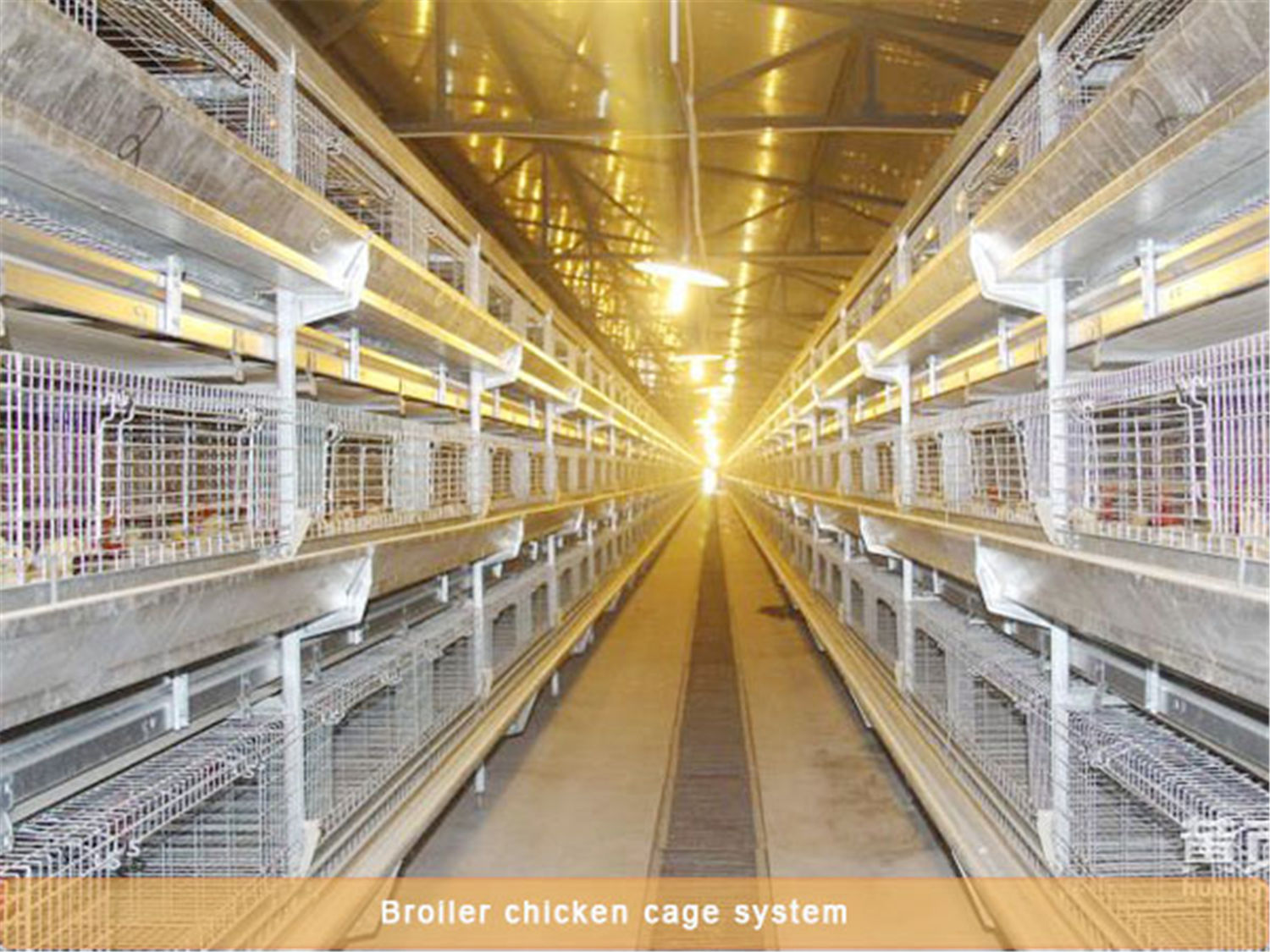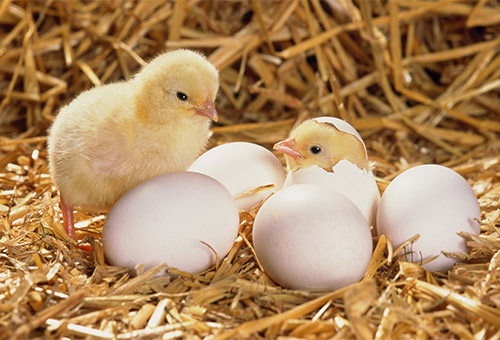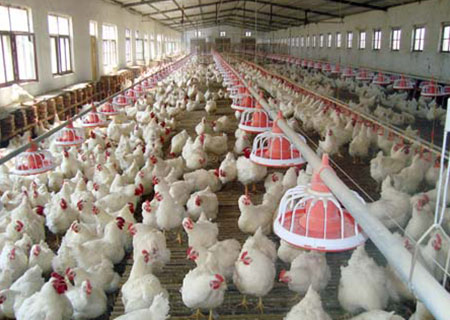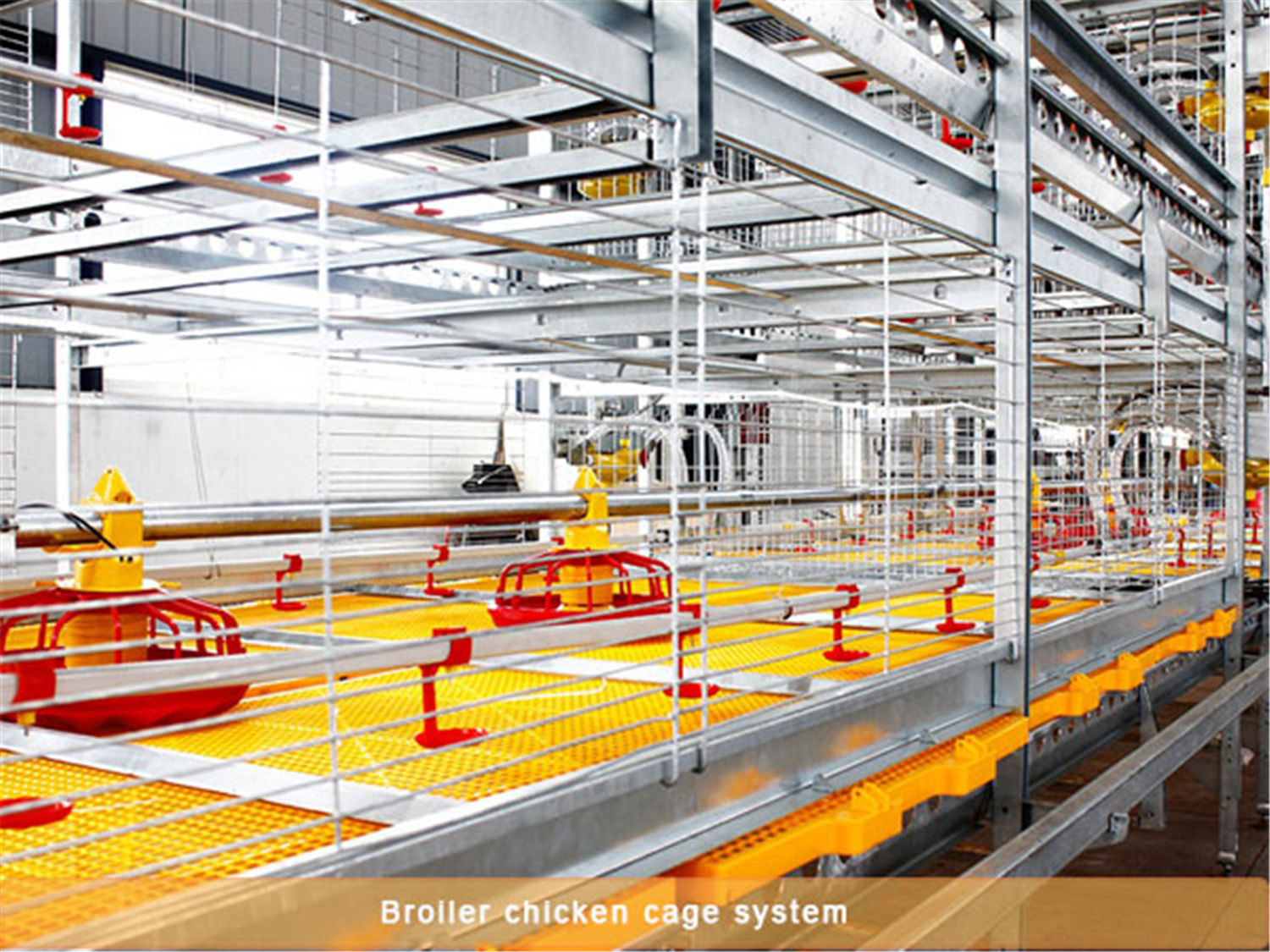What is the Most Important Thing When You Raise Broilers?
In early spring, it is easy to bring discomfort to the chickens in the broiler farms. At this time, the farmers must pay special attention to the rearing and management of the chickens in the broiler farms, and master the necessary broiler breeding techniques to achieve the guarantee of broiler farms. The healthy development of the broilers can lead you a bright feature.

The chickens should ensure that they can drink water within 2 hours after entering the house. For some weak seedlings, artificial drinking can be used to make them drink water. The purpose is to let the chicks learn to drink as soon as possible. The first time the chicks use water at 25°C, add 5% dextrose and 0.1% vitamin C to the water. The waterer should be washed frequently. During the entire brooding period, the drinking water should not be interrupted. From the second day of the brooding, the drinking water should be added. drug.
Advantages of broiler cage equipment
The use of broiler cage equipment is common in many large and medium-sized chicken farms. Except for some farms that are used to free-range, most chicken farms choose to use broiler cage equipment as a device for raising chickens. The broiler cage manufacturers said that the use of broiler cage equipment can collect and manage chickens, save energy, and effectively reduce the incidence of poultry diseases. Let's talk about the advantages of broiler cage equipment.
1. High degree of automation: automatic feeding, drinking water, clearing dung, wet curtain cooling, centralized management, automatic control, saving energy, improving labor productivity, reducing the cost of artificial breeding, and greatly improving the breeding efficiency of farmers.

2. The flock is well-prevented and effective in preventing infectious diseases: chickens do not touch the feces, which can make the chickens grow healthier and provide a clean and comfortable growing environment for the chickens.
3. Save space and increase stocking density: The cage density is more than 3 times higher than the flattening density.
4. Saving farmed feed: caged chickens can save a large amount of farmed feed, chickens are kept in cages, the amount of exercise is reduced, energy consumption is small, and waste materials are reduced. The data show that cage farming can effectively save more than 25% of farming costs.
5. Rugged and durable: The caged broiler complete set of equipment uses hot dip galvanizing process, corrosion resistance, aging resistance, and the service life can be as long as 15~20 years.
Advantages and Disadvantages of Broiler Ground Thick-bed Feeding Slat
The broiler ground thick litter feeding refers to feeding 5-10 centimeters of litter on the ground of a strictly sterilized chicken house, and the entire period of growth of the chicken is fully maintained on the litter. The litter requires soft, dry, strong water absorption, is not easy to compact, does not mold, no pollution. During the rearing process, loosening of padding material, removal of wet litter, and addition of new litter should be made as appropriate.
Advantages: Suitable for broiler growth and development, slightly lower than the Internet temperature during the hot season. Usually do not remove the feces, do not change the litter, save time and labor; in the winter can use litter fermentation heat production and increase Shewen; chicks in the litter activity increased, reduced the incidence of earthworms. Easy to use, low equipment investment, low incidence of breast cysts, and low defective products.

Disadvantages: It requires a lot of litter, repeated investment. The management of litter is difficult. If the management is not good and the litter is wet, various diseases of the digestive tract and respiratory tract infections are prone to occur: such as E. coli, coccidiosis, and chronic respiratory diseases. Direct contact between chickens and feces, the incidence of coccidiosis increased, and other infectious diseases are prevalent. The contradiction between ventilation and heat preservation is prominent, and health management is difficult. Chicken manure use value is reduced.
Main points of feeding and management of using broiler cages to raise chickens
For broiler breeding, most farmers now use broiler cages for breeding. The use of broiler chicken cages to raise chickens is more conducive to the management of the chickens by the farmers, and it is also more conducive to the rapid growth of the chickens. However, if the farmers do not use scientific and reasonable breeding methods to raise chickens, it will be difficult for the chickens to grow well. Today, I will give a detailed account of several key breeding points that farmers should pay attention to when using broiler cages to raise chickens.
1. Group the chickens
When the three-dimensional broiler cages are used to raise chickens, they usually use whole sports chicks. When the density of chicks is too large, group them in a timely manner to ensure that the weight of the chicks is even. The first grouping is usually 12-16 days old. The grouping is too early. It is easy to drill through the gaps in the growing cage, and it will cause a waste of space and energy. The second grouping, at 25-28 days of age, this time grouping should place the heavier healthy parts in the lower layer, leaving the weak young. In summer, because the temperature is too high, grouping can be carried out in advance. In winter, the temperature is cold and the temperature difference between the upper and lower cages is large. You can appropriately delay the time of cage division, and put one more in the lower cage to reduce the temperature difference between the upper and lower cages.

2. Control of temperature
When the temperature outside the chicken house is lower, the temperature difference between each layer is greater. Under normal circumstances, brooding are placed on the highest level, because the highest level has a higher temperature, which is conducive to saving heat. On the first day the chicks enter the farm, the temperature should be controlled at 33-34°C, which can also be adjusted according to the state of the chicks. When the temperature is right, the chickens are evenly distributed, lively, and have a strong appetite. When the temperature becomes low, shrink the neck and bow back and concentrate on the heat source. Squeezing each other, their bodies tremble. When the temperature is too high, water consumption increases, appetite decreases, breathing speeds up, and there is water in neck feathers. In the first week, the temperature dropped to 30°C, and then dropped by 2°C every week thereafter. The use of chicken cages to raise chickens has a high density, which is 1 to 2°C lower than the normal temperature. It is necessary to avoid the phenomenon of heat stress in the flock that causes a decrease in feed intake.
3. Disinfect the chicken house
The chicken house should be thoroughly cleaned and disinfected 5 days before the chicks are put into the house. Here, the farmers need to pay attention to avoid using caustic soda and other corrosive disinfectants for disinfection. After the chicks are in the house, the ground is cleaned every day, and the chickens are disinfected every other day.
4. Drinking water for chickens
After the chicks are placed in the house, it is necessary to ensure that they can drink clean and sanitary water within 2 hours. For the first time the chicks drink water, use warm water at 25°C, add 5% glucose and 0.1% vitamin C to the water, and rinse the drinking fountain frequently. Drinking water should not be interrupted throughout the brooding period. From the second day of brooding, add drugs to prevent pullorum in the drinking water.
The above is the summary to the farmers today, in the process of using broiler feeding cages to raise chickens in Uganda, the main points for the management of chicken flocks. I hope that through today's description, farmers can pay more attention to these points in their future breeding work.
Reasonable selection of broiler breeding equipment
Broiler feeding equipment is a relatively popular breeding equipment in modern times. The emergence of such equipment has helped farmers solve many problems, while also protecting the environment and reducing environmental pollution. Everyone should also understand some of the advantages of fully automatic chicken equipment, but even the best equipment, if used improperly, there will be misunderstandings, then everyone knows the misunderstanding of automatic chicken farming equipment? Don't worry about it first, let's take a look at everything.
Two common mistakes in the use of broiler equipment:
1. Choose cheaper when purchasing broiler equipment: The cost of raising chicken equipment to raise chickens is much higher than that of the past. Therefore, many users tend to prefer cheap equipment when purchasing chicken equipment, and pay attention to the quality of equipment. Whether the requirements and standards are met, especially chicken cage equipment, chicken cages are the main equipment for raising chickens. Chicken cages with poor structure and poor quality will affect the growth and production of chickens, and the age is not guaranteed.

2. Do not pay attention to the maintenance of broiler equipment: Since the chicken farming equipment is generally large-scale mechanized equipment, the service life is relatively long, and the farmers need to carry out reasonable inspection and maintenance work on each broiler equipment on a regular basis, which can promptly find problems and The fault is solved, and the service life of the equipment can be ensured and extended, and the efficiency of the chicken raising work of the farmers is exerted. However, many farmers have neglected the work, resulting in short service life, high failure rate and increased cost.
Regarding the misunderstanding of broiler equipment, misunderstanding of equipment maintenance and the correct method of selecting broiler equipment, broiler equipment manufacturers can only analyze it here. I hope these contents can help you solve some problems.
A Reasonable Broiler House Layout
A reasonable structure of the chicken house can provide a good living environment for the chickens including of equipment used in poultry farming, so that they can fully exert their production potential. Therefore, in addition to understanding the physiological characteristics of the chicken itself, the chicken house must be reasonably planned and constructed.
First, chicken layout considerations
1. The site should be chosen away from the residential area, convenient transportation, and far from the road.
2. The terrain is dry and sunny. As far as possible, it is not blocked in winter, no wind in summer, and no water after rain. Large area, leaving room for development
3. Rich in water resources, no pollution, easy to access, sufficient power and protection

4. The structure of the house is practical and economical. It not only saves funds but also saves energy as well as about chicken cages for sale. Its orientation is in line with local natural and physiological conditions. It is well lit, easy to ventilate and easy to operate. It is good for summer heatstroke and cool, and winter is good for heat preservation and cold protection.
5. The layout of the premises should be reasonable, so that the production area is separated from the non-production area. The non-production area and the water source are in the upwind direction of the chicken farm. The dirty road and the clean road are separated and do not cross. The manure field is located in the downwind direction of the chicken farm, and the brooding Separated from the breeding house, the brooding house is located in the upwind direction of the chicken farm.
Reasons for dyspepsia in chicken houses
Nowadays, most farmers raise broiler chickens by using battery cage for broilers. It is convenient and quick to use automatic feeding equipment, and it also saves feed waste. But now, as the summer is about to pass, the autumn will follow, and the rain will be wet. Sometimes there will be a state of indigestion. In fact, there are many factors to consider for this problem.
Feed mold infection, mycotoxins can cause digestive diseases such as oral cavity, intestinal tract, causing indigestion, mycotoxin contamination including feeding mildewed feed, and pollution in processing, transportation and storage. Due to the hot weather, the oil is corrupted due to improper preservation, causing broilers to cause glandular gastritis, muscle erosion and enteritis. Free radicals or reactive oxygen molecules produced by fatty acids can affect their immunity, slow down growth, cause poor pigmentation and cause enteritis. Excessive fat addition can cause lubricative diarrhea.

The nutritional requirements of broilers are relatively high in chicken battery cages . The low content of crude fiber in the feed will result in unbalanced nutrition and excessive crude fiber, resulting in large feed intake of broilers and confusion of gastrointestinal function, which may also cause indigestion. Insufficient energy in the feed The broiler is eating for energy, not enough energy, increasing the feed intake of the broiler, causing other nutrients not directly absorbed and directly excreted, thereby causing indigestion.
It is necessary to know that broilers grow fast, especially the growth of internal organs is 35 days ago; because of the low anti-stress ability of broilers, the environmental requirements are higher. There is no regularity in broiler cage feeding, overeating, or stressing the chicken, or causing the chicken to experience low temperatures at a constant temperature, which can cause indigestion. 60% of broiler chickens are made of water, so there must be sufficient drinking water to meet the needs of the chickens, while some farmers do not pay attention to drinking water sanitation, drinking polluted water or degraded water, causing chicken indigestion.
The Breeding Density of Broilers
Farming baby chickens for baroilers adopts a combination of whole-house brooding and upper cage brooding. The number of broods per cage is only 25, and there is no problem of crowding. The rearing density of caged broiler chickens is related to the season. The summer stocking density is low, and the winter stocking density can be appropriately increased. Generally, 8-9 pigs are fed in each cage.

Under the conditions of adopting ground litter and keeping the animals online, chickens should be divided into several small groups within the house. The number of chickens per group should be between 200 and 300. When divided into groups, they should be weighed according to their size, physical strength, and public health. The mother carries on, the individual characteristic in each small group must be basically similar. The characteristics of individuals in the group are similar, which is conducive to the even development of the group and helps to increase the survival rate of the chicks.
More...
Characteristics and dimensions of three tiers of broiler cages
In the past, farmers raised broilers in flat greenhouses, and the number of breeding was small. It has been difficult to meet the market demand for chicken product quality. Moreover, the simple raising equipment may cause the disease to be difficult to control, which will inevitably affect the meat output of broilers. However, the broiler cage raising equipment vigorously promoted by the breeding industry can implement automatic fecal removal, so that the broiler is separated from the fecal sewage, achieving less incidence, fast growth, good quality and good benefits. Now the author will talk about the characteristics and dimensions of broiler cages.
Characteristics of broiler cages:
1. The stacked broiler cages produced by high-quality poultry equipment suppliers use a full set of hot-dip galvanizing technology, which is corrosion-resistant and has a service life of more than 20 years.
2. The material of Q235 has great elasticity and is not easy to bend.
3. The high-density breeding saves land, which is about 70% less than the stepped land.

4. Centralized management, save energy and resources, adopt advanced ventilation system, lighting system and automatic control system to fully save energy consumption and improve labor productivity.
5. Save space and increase the feeding density to more than 60 animals/m2.
6. The unique cage door design effectively prevents the chicken from shaking its head up and down when it is eating.
7. The use of conveyor belt to clean the manure to dry the chicken manure into granules, reduce environmental pollution, and high reuse rate of chicken manure.
8. Eco-environmental protection is the most ideal feeding equipment for green chicken and environmental protection egg products.
Broiler cage size:
The cascading broiler cages have three layers and two doors. Each group has a length of 140cm, each group spans 200cm, the number of units is 6, the unit length is 70cm, the unit depth is 70cm, the cage height is 38cm, and the feeding amount is 60.
Stacked broiler cages with four layers and two doors, each group length 140cm, each group span 200cm, unit number 8, unit number 70cm, unit depth 70cm, cage height 38cm, feeding capacity 80.
Each poultry farming equipment supplier provides different sizes of chicken cages, so when buying, you only need to buy according to your own needs, and you don't need to be constrained by the size of the chicken cage.
Broiler Breeding Technology in Chicken Farm
More and more farmers are beginning to develop the breeding industry. Large-scale breeding of chickens requires the use of Poultry Rearing Equipment, such as broiler cages, dung removal equipment and feeding equipment. However, in addition to these breeding equipment, if you want to raise chickens well and bring economic benefits to yourself, you still need certain breeding technology. The following are the key points of broiler breeding technology.
First of all, large-scale farming requires a farm. We need to know where is the best place for chicken farm construction. The selection of chicken farm site is directly related to the epidemic prevention status and economic benefits of chicken farms. According to the size of the breeding scale and the resource conditions, it is necessary to have a clear view of the convenient transportation of the chicken coop, sufficient water resources and guarantee the power supply. Electricity is required for lighting, water supply, temperature supply, ventilation, etc. in the chicken farm, so the chicken farm requires sufficient power supply. Environmental conditions are good and there is room for development.

Chicken coops are places where chickens live healthily. When building chicken coops, attention should be paid to the performance of heat preservation, heat insulation, ventilation and lighting, moisture prevention, ease of production and operation, disinfection and epidemic prevention, etc. At present, there are many types of buildings in chicken coops, which can be divided into two categories: open type and closed type according to different building structures and performances. Closed henhouse is also called windowless henhouse, because it is relatively closed to the outside world, has the function of temperature isolation and shading, and can adjust and control the internal environment of the henhouse. It has greater advantages than open henhouse, but it has high cost and large infrastructure investment.
Broilers for meat are more suitable for high-density feeding, and the feeding amount depends on the effective feeding area of the chicken house and the appropriate feeding density in battery cage for chickens. However, in actual production, the amount of breeding is restricted by many factors. The first is the number of breeders, the second is the feed supply capacity and the source of chickens, and the third is the area of chicken houses. Under the condition that there is no problem with the first two, the feeding amount depends on the area of the chicken coop.
There are two types of ventilation in chicken coops: mechanical ventilation and natural ventilation. There are mainly two types of mechanical ventilation in closed chicken coops, namely, horizontal ventilation and vertical ventilation. These are the key points of raising chickens in the poultry house, hoping to help farmers build a suitable chicken farm.
